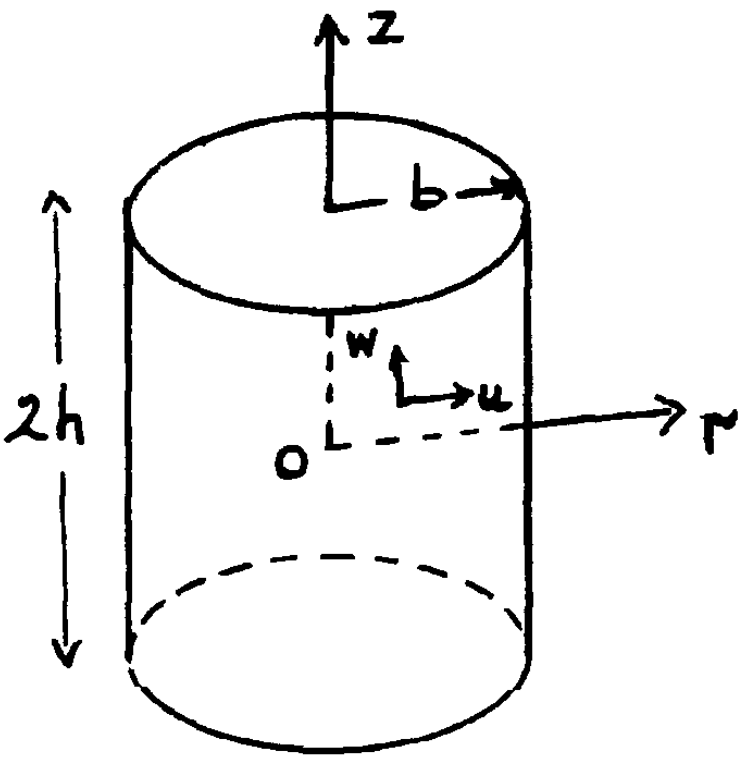Elasticity (small and large deformation)
Table of contents
- 1 NAFEMS LE10 “Thick plate pressure” benchmark
- 2 NAFEMS LE11 “Solid Cylinder/Taper/Sphere-Temperature” benchmark
- 3 NAFEMS LE1 “Elliptical membrane” plane-stress benchmark
- 4 Parametric study on a cantilevered beam
- 5 Parallelepiped whose Young’s modulus is a function of the temperature
- 6 Orthotropic free expansion of a cube
- 7 Thermo-elastic expansion of finite cylinders
- 8 Temperature-dependent material properties
- 9 Two cubes compressing each other
- 10 Steel/aluminum paradox
- 11 NAFEMS GNL5 “Large-deformation beam”
1 NAFEMS LE10 “Thick plate pressure” benchmark
Assuming the CAD has already been created in STEP format (for instance using Gmsh with this
geo file), create a tetrahedral locally-refined unstructured grid
with Gmsh using the following .geo file:
// NAFEMS LE10 benchmark unstructured locally-refined tetrahedral mesh
Merge "nafems-le10.step"; // load the CAD
// define physical names from the geometrical entity ids
Physical Surface("upper") = {7};
Physical Surface("DCD'C'") = {1};
Physical Surface("ABA'B'") = {3};
Physical Surface("BCB'C'") = {4, 5};
Physical Curve("midplane") = {14};
Physical Volume("bulk") = {1};
// meshing settings, read Gmsh' manual for further reference
Mesh.ElementOrder = 2; // use second-order tetrahedra
Mesh.Algorithm = 6; // 2D mesh algorithm: 6: Frontal Delaunay
Mesh.Algorithm3D = 10; // 3D mesh algorithm: 10: HXT
Mesh.Optimize = 1; // Optimize the mesh
Mesh.HighOrderOptimize = 1; // Optimize high-order meshes? 2: elastic+optimization
Mesh.MeshSizeMax = 80; // main element size
Mesh.MeshSizeMin = 20; // refined element size
// local refinement around the point D (entity 4)
Field[1] = Distance;
Field[1].NodesList = {4};
Field[2] = Threshold;
Field[2].IField = 1;
Field[2].LcMin = Mesh.MeshSizeMin;
Field[2].LcMax = Mesh.MeshSizeMax;
Field[2].DistMin = 2 * Mesh.MeshSizeMax;
Field[2].DistMax = 6 * Mesh.MeshSizeMax;
Background Field = {2};and then use this pretty-straightforward input file that has a one-to-one correspondence with the original problem formulation from 1990:
# NAFEMS Benchmark LE-10: thick plate pressure
PROBLEM mechanical MESH nafems-le10.msh # mesh in millimeters
# LOADING: uniform normal pressure on the upper surface
BC upper p=1 # 1 Mpa
# BOUNDARY CONDITIONS:
BC DCD'C' v=0 # Face DCD'C' zero y-displacement
BC ABA'B' u=0 # Face ABA'B' zero x-displacement
BC BCB'C' u=0 v=0 # Face BCB'C' x and y displ. fixed
BC midplane w=0 # z displacements fixed along mid-plane
# MATERIAL PROPERTIES: isotropic single-material properties
E = 210e3 # Young modulus in MPa
nu = 0.3 # Poisson's ratio
# print the direct stress y at D (and nothing more)
PRINTF "σ_y @ D = %.4f MPa" sigmay(2000,0,300)
# write post-processing data for paraview
WRITE_RESULTS$ gmsh -3 nafems-le10.geo
[...]
$ feenox nafems-le10.fee
sigma_y @ D = -5.37968 MPa
$
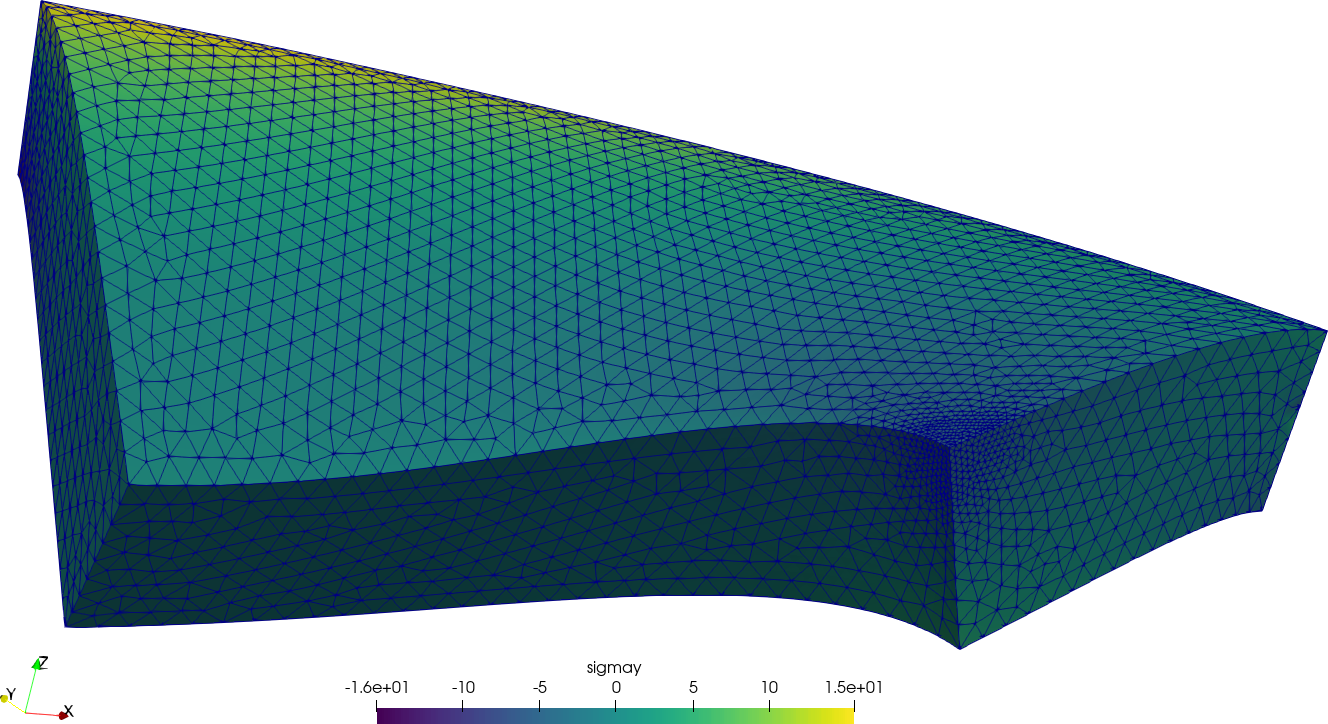
2 NAFEMS LE11 “Solid Cylinder/Taper/Sphere-Temperature” benchmark
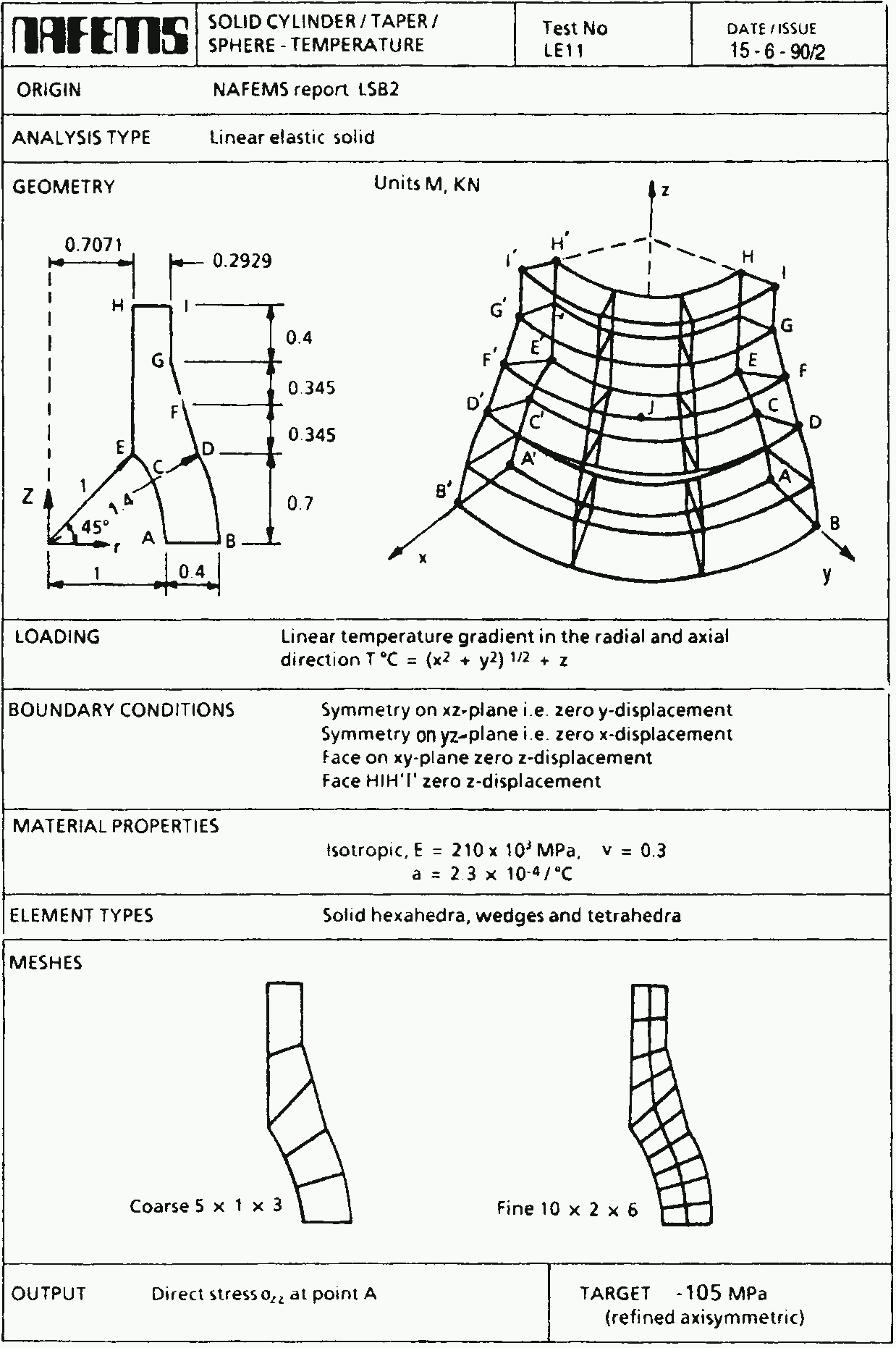
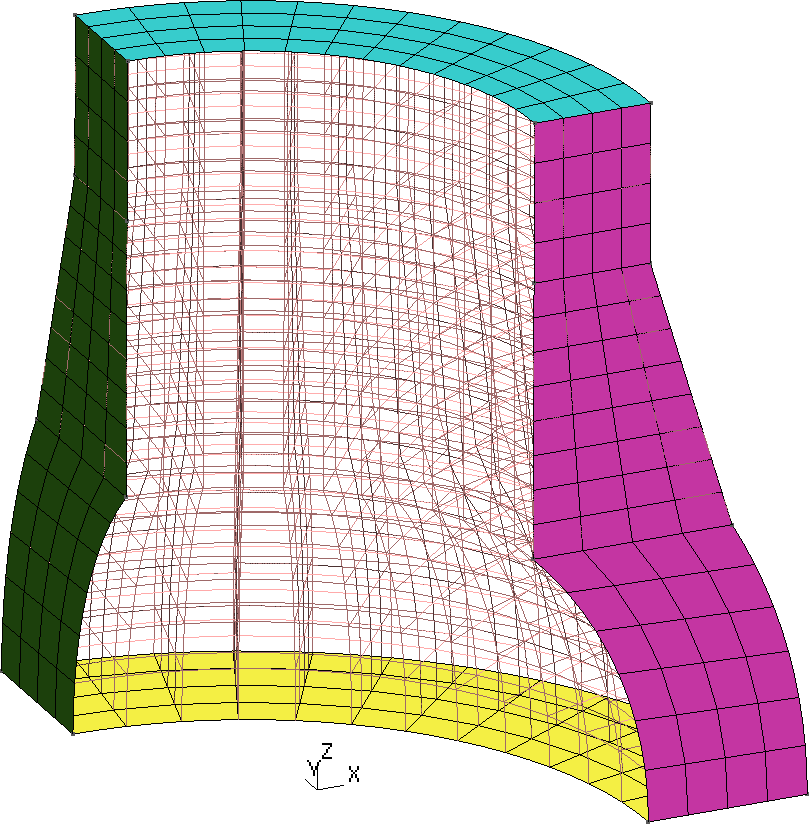
Figure 1: The NAFEMS LE11 problem formulation. a — Problem statement, b — Structured hex mesh
Following the spirit from LE10, note how easy it is to give a
space-dependent temperature field in FeenoX. Just write \sqrt{x^2+y^2}+z like
sqrt(x^2 + y^2) + z!
# NAFEMS Benchmark LE-11: solid cylinder/taper/sphere-temperature
PROBLEM mechanical 3D MESH nafems-le11.msh
# linear temperature gradient in the radial and axial direction
# as an algebraic expression as human-friendly as it can be
T(x,y,z) = sqrt(x^2 + y^2) + z
BC xz v=0 # displacement vector is [u,v,w]
BC yz u=0 # u = displacement in x
BC xy w=0 # v = displacement in y
BC HIH'I' w=0 # w = displacement in z
E = 210e3*1e6 # mesh is in meters, so E=210e3 MPa -> Pa
nu = 0.3 # dimensionless
alpha = 2.3e-4 # in 1/ºC as in the problem
SOLVE_PROBLEM
# for post-processing in Paraview
WRITE_MESH nafems-le11.vtk VECTOR u v w T sigmax sigmay sigmaz
PRINTF "sigma_z(A) = %.2f MPa" sigmaz(1,0,0)/1e6
PRINTF "wall time = %.2f seconds" wall_time()$ gmsh -3 nafems-le11.geo
[...]
$ feenox nafems-le11.fee
sigma_z(A) = -105.04 MPa
wall time = wall time = 1.91 seconds
$
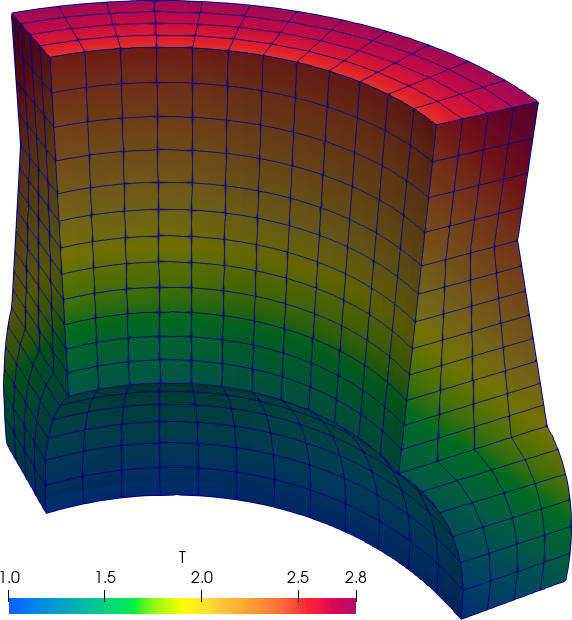
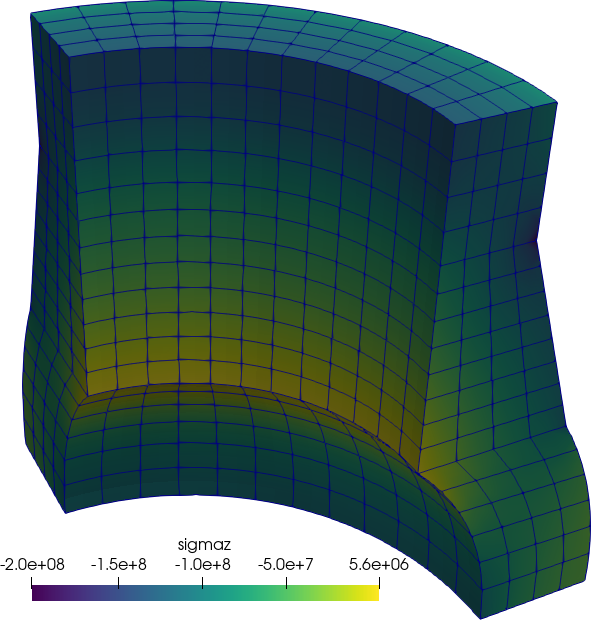
Figure 2: The NAFEMS LE11 problem results. a — Problem statement, b — Structured hex mesh
3 NAFEMS LE1 “Elliptical membrane” plane-stress benchmark
Tell FenooX the problem is plane_stress. Use the
nafems-le1.geo file provided to create the mesh. Read it
with READ_MESH, set material properties, BCs
and SOLVE_PROBLEM!
PROBLEM mechanical 2D plane_stress MESH nafems-le1.msh
E = 210e3
nu = 0.3
BC AB u=0
BC CD v=0
BC BC tension=10
SOLVE_PROBLEM
WRITE_MESH nafems-le1.vtk VECTOR u v 0 sigmax sigmay tauxy
PRINT "σy at point D = " %.4f sigmay(2000,0) "(reference is 92.7)" SEP " "$ gmsh -2 nafems-le11.geo
[...]
$ feenox nafems-le1.fee
σy at point D = 92.7011 (reference is 92.7)
$
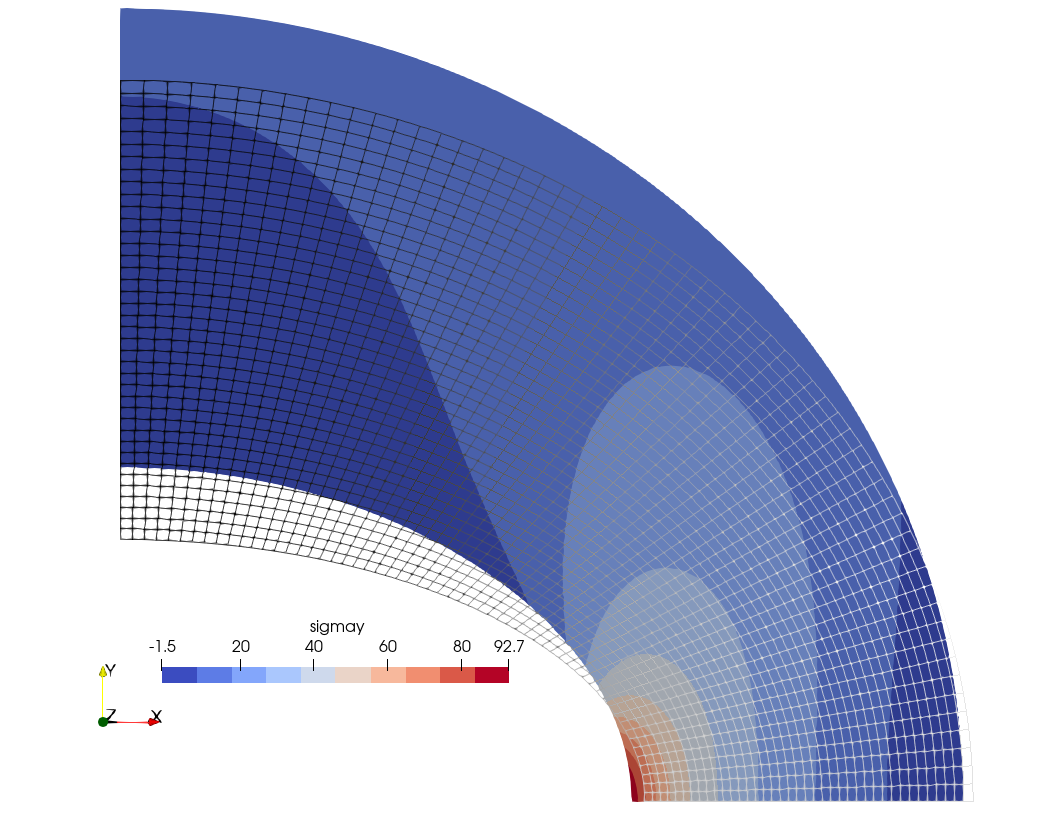
4 Parametric study on a cantilevered beam
If an external loop successively calls FeenoX with extra command-line
arguments, a parametric run is obtained. This file
cantilever.fee fixes the face called “left” and sets a load
in the negative z direction of a mesh
called cantilever-$1-$2.msh, where $1 is the
first argument after the input file and $2 the second one.
The output is a single line containing the number of nodes of the mesh
and the displacement in the vertical direction w(500,0,0) at the center of the cantilever’s
free face.
The following Bash script first calls Gmsh to create the meshes. To
do so, it first starts with a base cantilever.geo
file that creates the CAD:
// https://autofem.com/examples/determining_natural_frequencie.html
SetFactory("OpenCASCADE");
L = 0.5;
b = 0.05;
h = 0.02;
Box(1) = {0,-b/2,-h/2, L, b, h};
Physical Surface("left") = {1};
Physical Surface("right") = {2};
Physical Surface("top") = {4};
Physical Volume("bulk") = {1};
Transfinite Curve {1, 3, 5, 7} = 1/(Mesh.MeshSizeFactor*Mesh.ElementOrder) + 1;
Transfinite Curve {2, 4, 6, 8} = 2/(Mesh.MeshSizeFactor*Mesh.ElementOrder) + 1;
Transfinite Curve {9, 10, 11, 12} = 16/(Mesh.MeshSizeFactor*Mesh.ElementOrder) + 1;
Transfinite Surface "*";
Transfinite Volume "*";Then another .geo file is merged to build
cantilever-${element}-${c}.msh where
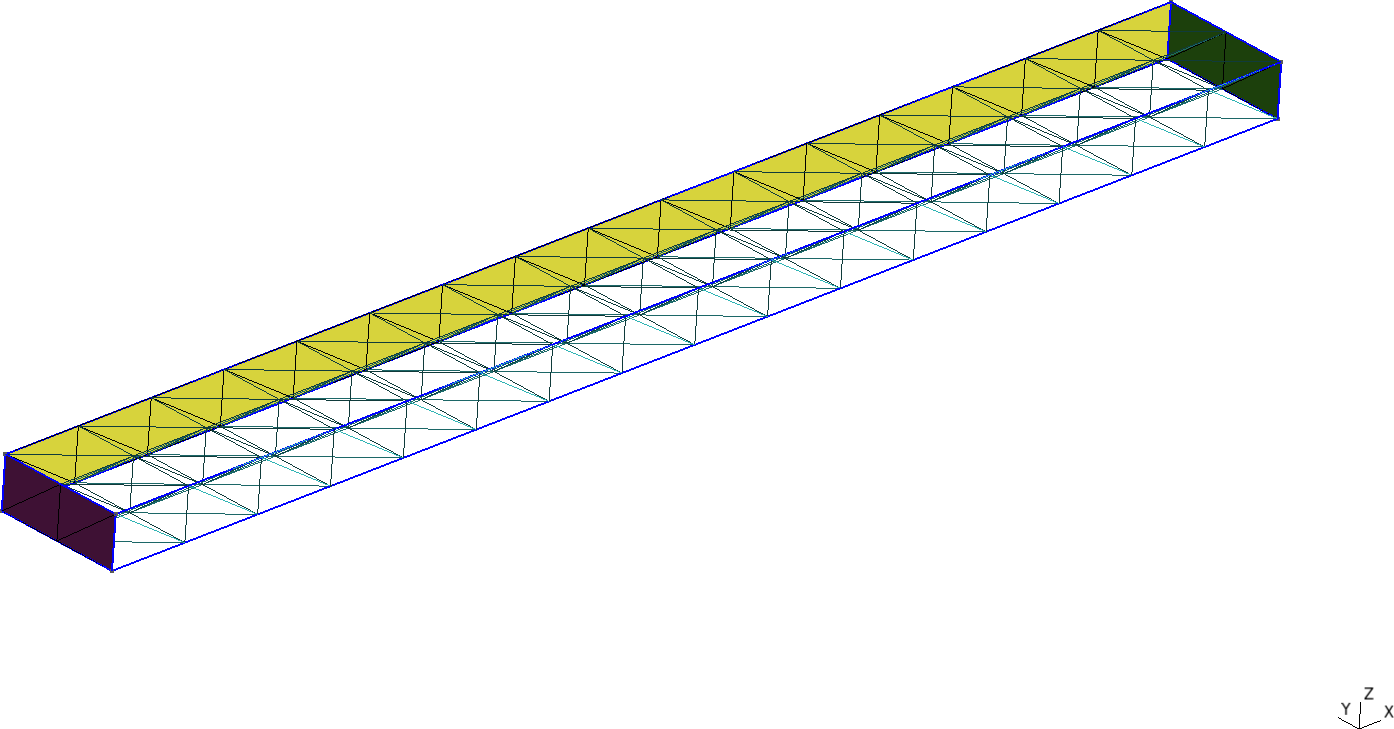
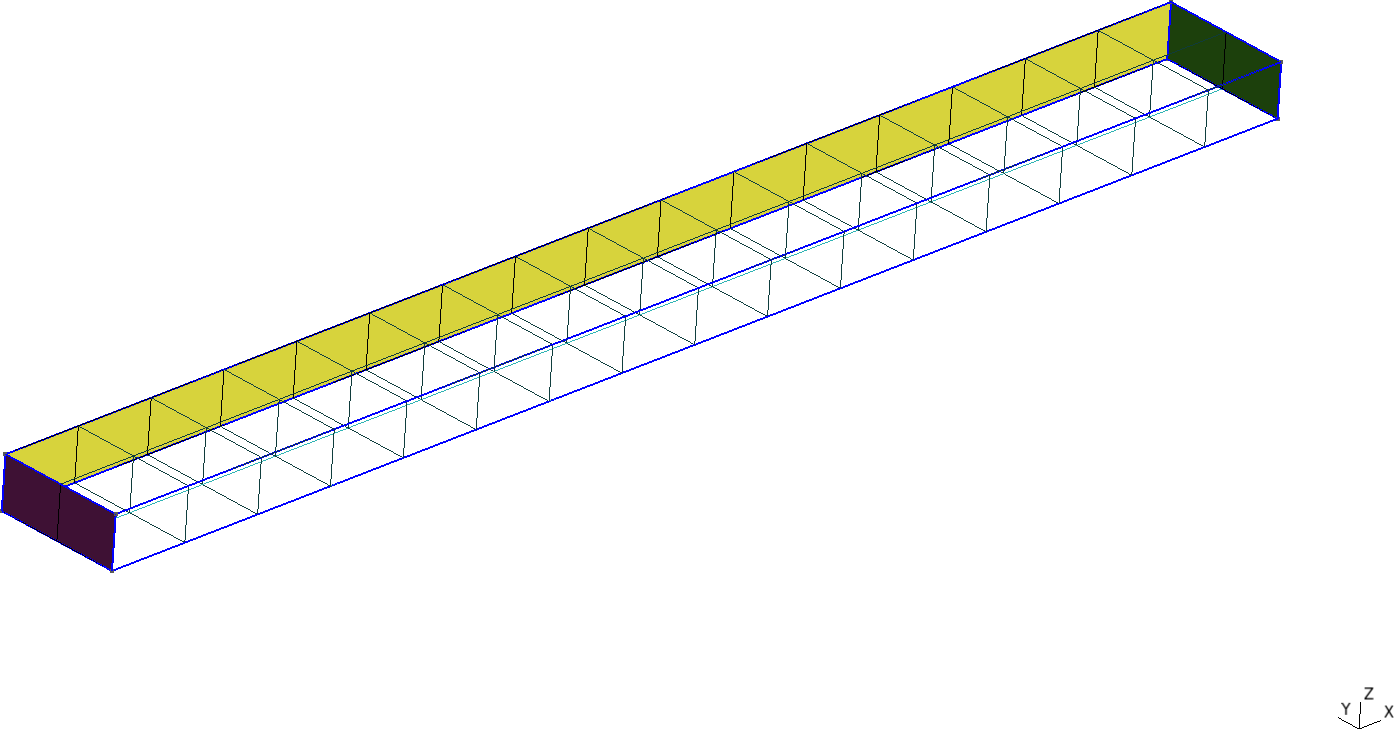
Figure 3: Cantilevered beam meshed with structured tetrahedra and hexahedra. a — Tetrahedra, b — Hexahedra
It then calls FeenoX with the input cantilever.fee
and passes ${element} and ${c} as extra
arguments, which then are expanded as $1 and
$2 respectively.
#!/bin/bash
rm -f *.dat
for element in tet4 tet10 hex8 hex20 hex27; do
for c in $(seq 1 10); do
# create mesh if not already cached
mesh=cantilever-${element}-${c}
if [ ! -e ${mesh}.msh ]; then
scale=$(echo "PRINT 1/${c}" | feenox -)
gmsh -3 -v 0 cantilever-${element}.geo -clscale ${scale} -o ${mesh}.msh
fi
# call FeenoX
feenox cantilever.fee ${element} ${c} | tee -a cantilever-${element}.dat
done
doneAfter the execution of the Bash script, thanks to the design decision
that output is 100% defined by the user (in this case with the
PRINT instruction), one has several files
cantilever-${element}.dat files. When plotted, these show
the shear locking effect of fully-integrated first-order elements. The
theoretical Euler-Bernoulli result is just a reference as, among other
things, it does not take into account the effect of the material’s
Poisson’s ratio. Note that the abscissa shows the number of
nodes, which are proportional to the number of degrees of
freedom (i.e. the size of the problem matrix) and not the number of
elements, which is irrelevant here and in most problems.
PROBLEM mechanical 3D
READ_MESH cantilever-$1-$2.msh # in meters
E = 2.1e11 # Young modulus in Pascals
nu = 0.3 # Poisson's ratio
BC left fixed
BC right tz=-1e5 # traction in Pascals, negative z
SOLVE_PROBLEM
# z-displacement (components are u,v,w) at the tip vs. number of nodes
PRINT nodes %e w(500,0,0) "\# $1 $2"$ ./cantilever.sh
102 -7.641572e-05 # tet4 1
495 -2.047389e-04 # tet4 2
1372 -3.149658e-04 # tet4 3
[...]
19737 -5.916234e-04 # hex27 8
24795 -5.916724e-04 # hex27 9
37191 -5.917163e-04 # hex27 10
$ pyxplot cantilever.ppl
5 Parallelepiped whose Young’s modulus is a function of the temperature
The problem consists of finding the non-dimensional temperature T and displacements u, v and w distributions within a solid parallelepiped of length l whose base is a square of h\times h. The solid is subject to heat fluxes and to a traction pressure at the same time. The non-dimensional Young’s modulus E of the material depends on the temperature T in a know algebraically way, whilst both the Poisson coefficient \nu and the thermal conductivity k are uniform and do not depend on the spatial coordinates:
\begin{aligned} E(T) &= \frac{1000}{800-T} \\ \nu &= 0.3 \\ k &= 1 \\ \end{aligned}
References:
- http://www.code-aster.org/V2/doc/default/fr/man_v/v7/v7.03.100.pdf
- https://www.seamplex.com/docs/SP-FI-17-BM-12F2-A.pdf
This thermo-mechanical problem is solved in two stages. First, the heat conduction equation is solved over a coarse first-order mesh to find the non-dimensional temperature distribution. Then, a mechanical problem is solved where T(x,y,z) is read from the first mesh and interpolated into a finer second-order mesh so to as evaluate the non-dimensional Young’s modulus as
E\Big(T(x,y,z)\Big) = \frac{1000}{800-T(x,y,z)}
Note that there are not thermal expansion effects (i.e. the thermal expansion coefficient is \alpha=0). Yet, suprinsingly enough, the problem has analytical solutions for both the temperature and the displacement fields.
5.1 Thermal problem
The following input solves the thermal problem over a coarse
first-order mesh, writes the resulting temperature distribution into
parallelepiped-temperature.msh, and prints the L_2 error of the numerical result with
respect to the analytical solution T(x,y,z) =
40 - 2x - 3y - 4z.
PROBLEM thermal 3D
READ_MESH parallelepiped-coarse.msh
k = 1 # unitary non-dimensional thermal conductivity
# boundary conditions
BC left q=+2
BC right q=-2
BC front q=+3
BC back q=-3
BC bottom q=+4
BC top q=-4
BC A T=0
SOLVE_PROBLEM
WRITE_MESH parallelepiped-temperature.msh T
# compute the L-2 norm of the error in the displacement field
Te(x,y,z) = 40 - 2*x - 3*y - 4*z # analytical solution, "e" means exact
INTEGRATE (T(x,y,z)-Te(x,y,z))^2 RESULT num
PHYSICAL_GROUP bulk DIM 3 # this is just to compute the volume
PRINT num/bulk_volume$ gmsh -3 parallelepiped.geo -order 1 -clscale 2 -o parallelepiped-coarse.msh
[...]
Info : 117 nodes 567 elements
Info : Writing 'parallelepiped-coarse.msh'...
Info : Done writing 'parallelepiped-coarse.msh'
Info : Stopped on Fri Dec 10 10:32:30 2021 (From start: Wall 0.0386516s, CPU 0.183052s)
$ feenox parallelepiped-thermal.fee
6.18981e-12
$
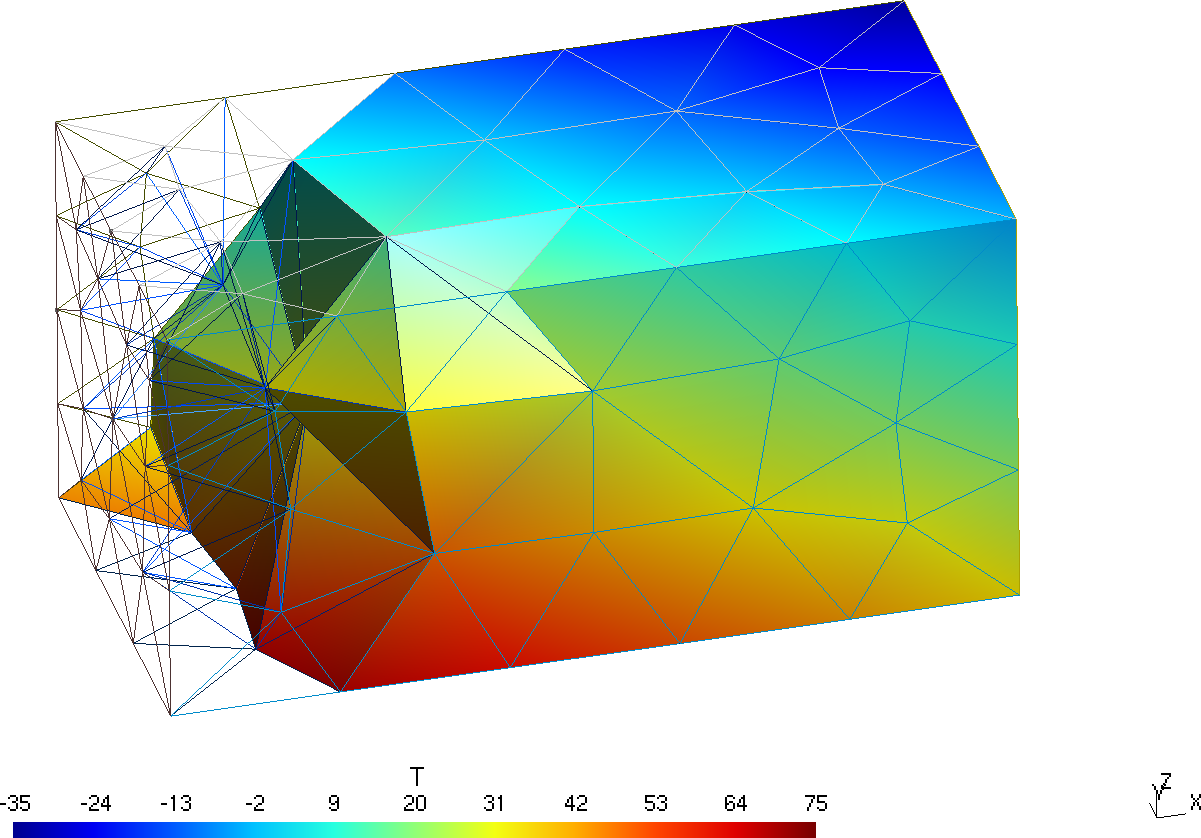
5.2 Mechanical problem
Now this input file reads the scalar function T stored
in the coarse first-order mesh file
parallelepiped-temperature.msh and uses it to solve the
mechanical problem in the finer second-order mesh
parallelepiped.msh. The numerical solution for the
displacements over the fine mesh is written in a VTK file (along with
the temperature as interpolated from the coarse mesh) and compared to
the analytical solution using the L_2
norm.
PROBLEM mechanical 3D
# this is where we solve the mechanical problem
READ_MESH parallelepiped.msh MAIN
# this is where we read the temperature from
READ_MESH parallelepiped-temperature.msh DIM 3 READ_FUNCTION T
# mechanical properties
E(x,y,z) = 1000/(800-T(x,y,z)) # young's modulus
nu = 0.3 # poisson's ratio
# boundary conditions
BC O fixed
BC B u=0 w=0
BC C u=0
# here "load" is a fantasy name applied to both "left" and "right"
BC load tension=1 PHYSICAL_GROUP left PHYSICAL_GROUP right
SOLVE_PROBLEM
WRITE_MESH parallelepiped-mechanical.vtk T VECTOR u v w
# analytical solutions
h = 10
A = 0.002
B = 0.003
C = 0.004
D = 0.76
# the "e" means exact
ue(x,y,z) := A/2*(x^2 + nu*(y^2+z^2)) + B*x*y + C*x*z + D*x - nu*A*h/4*(y+z)
ve(x,y,z) := -nu*(A*x*y + B/2*(y^2-z^2+x^2/nu) + C*y*z + D*y -A*h/4*x - C*h/4*z)
we(x,y,z) := -nu*(A*x*z + B*y*z + C/2*(z^2-y^2+x^2/nu) + D*z + C*h/4*y - A*h/4*x)
# compute the L-2 norm of the error in the displacement field
INTEGRATE (u(x,y,z)-ue(x,y,z))^2+(v(x,y,z)-ve(x,y,z))^2+(w(x,y,z)-we(x,y,z))^2 RESULT num MESH parallelepiped.msh
INTEGRATE 1 RESULT den MESH parallelepiped.msh
PRINT num/den$ gmsh -3 parallelepiped.geo -order 2
[...]
Info : 2564 nodes 2162 elements
Info : Writing 'parallelepiped.msh'...
Info : Done writing 'parallelepiped.msh'
Info : Stopped on Fri Dec 10 10:39:27 2021 (From start: Wall 0.165707s, CPU 0.258751s)
$ feenox parallelepiped-mechanical.fee
1.46196e-06
$
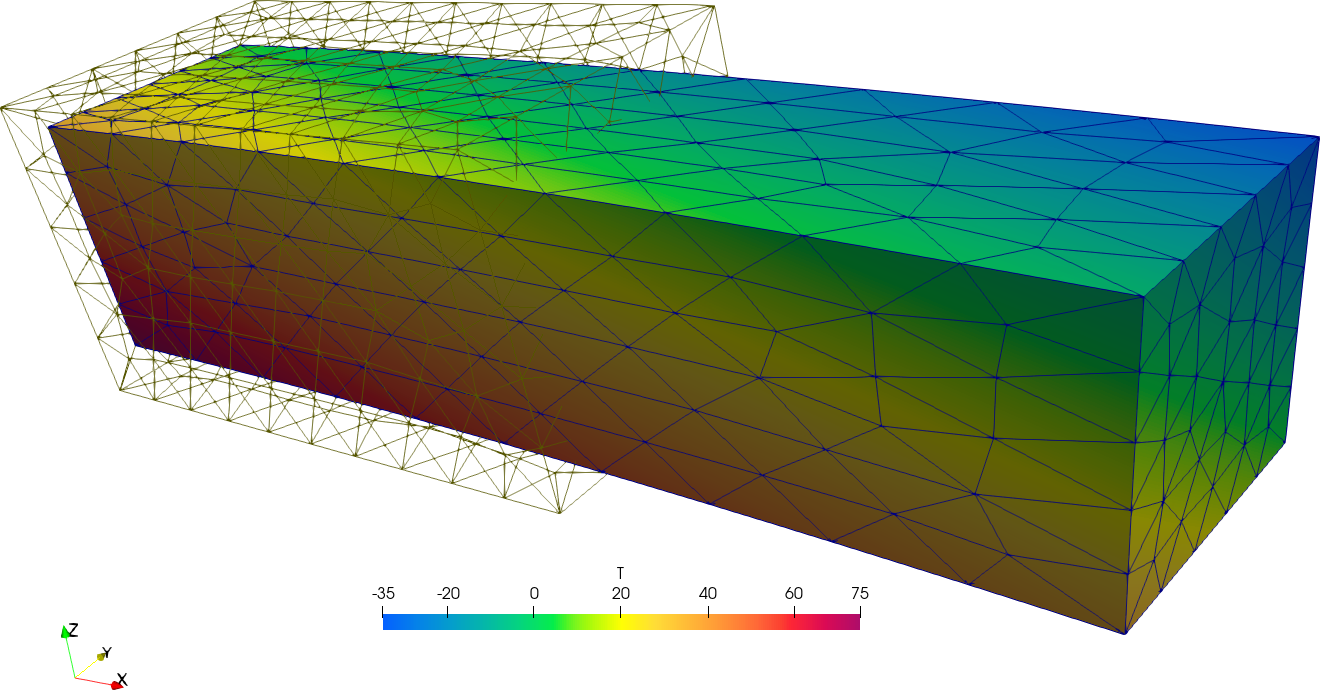
6 Orthotropic free expansion of a cube
To illustrate the point of the previous discussion, let us solve the thermal expansion of an unrestrained unitary cube [0,1~\text{mm}]\times[0,1~\text{mm}]\times[0,1~\text{mm}] subject to a linear radially-symmetric temperature field T(x,y,z) = 30 \text{ºC} + 150 \frac{\text{ºC}}{\text{mm}} \sqrt{x^2+y^2+z^2}
with a mean thermal expansion coefficient for each of the three directions x, y and z computed from each of the three columns of the ASME table TE-2, respectively. If the data was consistent, the displacement at any point with the same coordinates x=y=z would be exactly equal.
DEFAULT_ARGUMENT_VALUE 1 steffen
DEFAULT_ARGUMENT_VALUE 2 hex
PROBLEM mechanical
READ_MESH cube-$2.msh
# aluminum-like linear isotropic material properties
E = 69e3
nu = 0.28
# free expansion
BC left u=0
BC front v=0
BC bottom w=0
# reference temperature is 20ºC
T0 = 20
# spatial temperature distribution symmetric wrt x,y & z
T(x,y,z) = 30+150*sqrt(x^2+y^2+z^2)
# read ASME data
FUNCTION A(T') FILE asme-expansion-table.dat COLUMNS 1 2 INTERPOLATION $1
FUNCTION B(T') FILE asme-expansion-table.dat COLUMNS 1 3 INTERPOLATION $1
FUNCTION C(T') FILE asme-expansion-table.dat COLUMNS 1 4 INTERPOLATION $1
# remember that the thermal expansion coefficients have to be
# 1. the mean value between T0 and T
# 2. functions of space, so temperature has to be written as T(x,y,z)
# in the x direction, we use column B directly
alpha_x(x,y,z) = 1e-6*B(T(x,y,z))
# in the y direction, we convert column A to mean
alpha_y(x,y,z) = 1e-6*integral(A(T'), T', T0, T(x,y,z))/(T(x,y,z)-T0)
# in the z direction, we convert column C to mean
alpha_z(x,y,z) = 1e-3*C(T(x,y,z))/(T(x,y,z)-T0)
SOLVE_PROBLEM
WRITE_MESH cube-orthotropic-expansion-$1-$2.vtk T VECTOR u v w
PRINT %.3e "displacement in x at (1,1,1) = " u(1,1,1)
PRINT %.3e "displacement in y at (1,1,1) = " v(1,1,1)
PRINT %.3e "displacement in z at (1,1,1) = " w(1,1,1)$ gmsh -3 cube-hex.geo
[...]
$ gmsh -3 cube-tet.geo
[...]
$ feenox cube-orthotropic-expansion.fee
displacement in x at (1,1,1) = 4.451e-03
displacement in y at (1,1,1) = 4.449e-03
displacement in z at (1,1,1) = 4.437e-03
$ feenox cube-orthotropic-expansion.fee linear tet
displacement in x at (1,1,1) = 4.452e-03
displacement in y at (1,1,1) = 4.447e-03
displacement in z at (1,1,1) = 4.438e-03
$ feenox cube-orthotropic-expansion.fee akima hex
displacement in x at (1,1,1) = 4.451e-03
displacement in y at (1,1,1) = 4.451e-03
displacement in z at (1,1,1) = 4.437e-03
$ feenox cube-orthotropic-expansion.fee splines tet
displacement in x at (1,1,1) = 4.451e-03
displacement in y at (1,1,1) = 4.450e-03
displacement in z at (1,1,1) = 4.438e-03
$
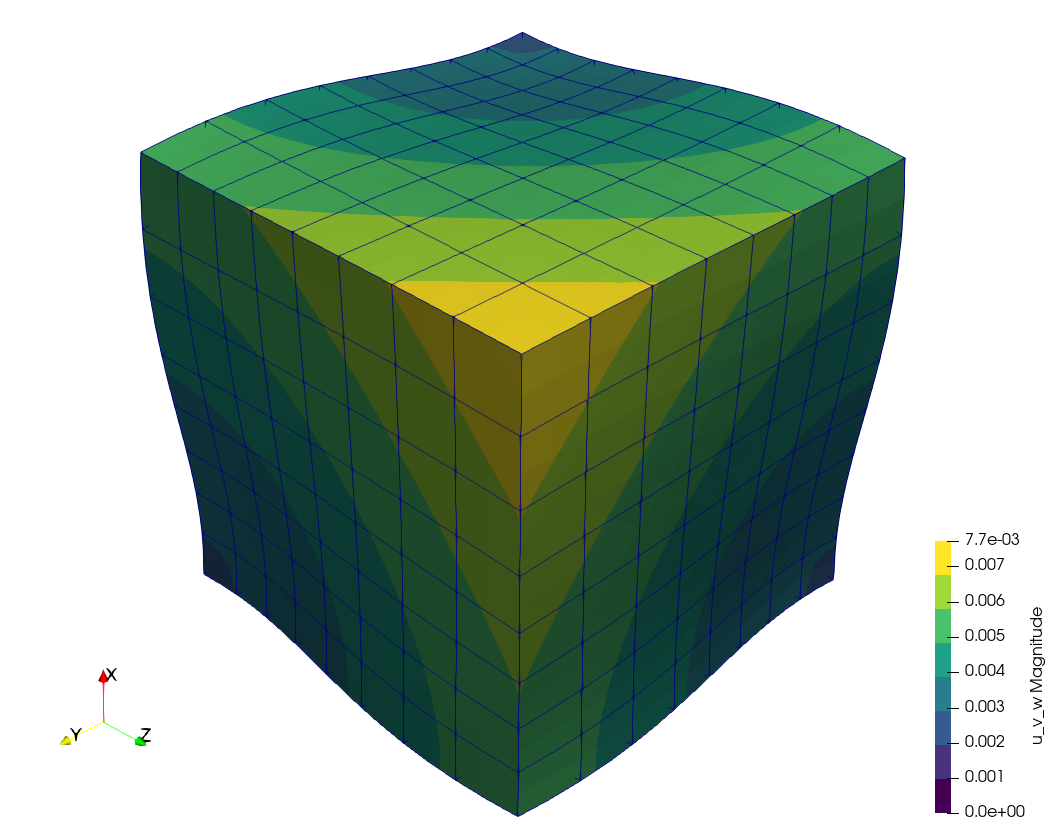
Differences cannot be seen graphically, but they are there as the terminal mimic illustrates. Yet, they are not as large nor as sensible to meshing and interpolation settings as one would have expected after seeing the plots from the previous section.
7 Thermo-elastic expansion of finite cylinders
Let us solve the following problem introduced by J. Veeder in his technical report AECL-2660 from 1967.
Consider a finite solid cylinder (see insert) of radius b and length 2h, with the origin of coordinates at the centre. It may be shown that the temperature distribution in a cylindrical fuel pellet operating in a reactor is given approximately by
T(r) = T_0 + T_1 \cdot \left[ 1 - \left(\frac{r}{b} \right)^2 \right]
where T_0 is the pellet surface temperature and T_1 is the temperature difference between the centre and surface. The thermal expansion is thus seen to be the sum of two terms, the first of which produces uniform expansion (zero stress) at constant temperature T_0, and is therefore computationally trivial. Tho second term introduces non-uniform body forces which distort the pellet from its original cylindrical shape.
The problem is axisymmetric on the azimutal angle and
axially-symmetric along the mid-plane. The FeenoX input uses the
tangential and radial boundary conditions
applied to the base of the upper half of a 3D cylinder. The geometry is
meshed using 27-noded hexahedra.
Two one-dimensional profiles for the non-dimensional range [0:1] at the external surfaces are written into an ASCII file ready to be plotted:
- axial dependency of the displacement v(z') = v(0,v,z'h) in the y direction at fixed x=0 and y=b, and
- radial dependency of the displacement w(r') = w(0,r'b, h) in the z direction at fixed x=0 and z=h
These two profiles are compared to the power expansion series given in the original report from 1967. Note that the authors expect a 5% difference between the reference solution and the real one.
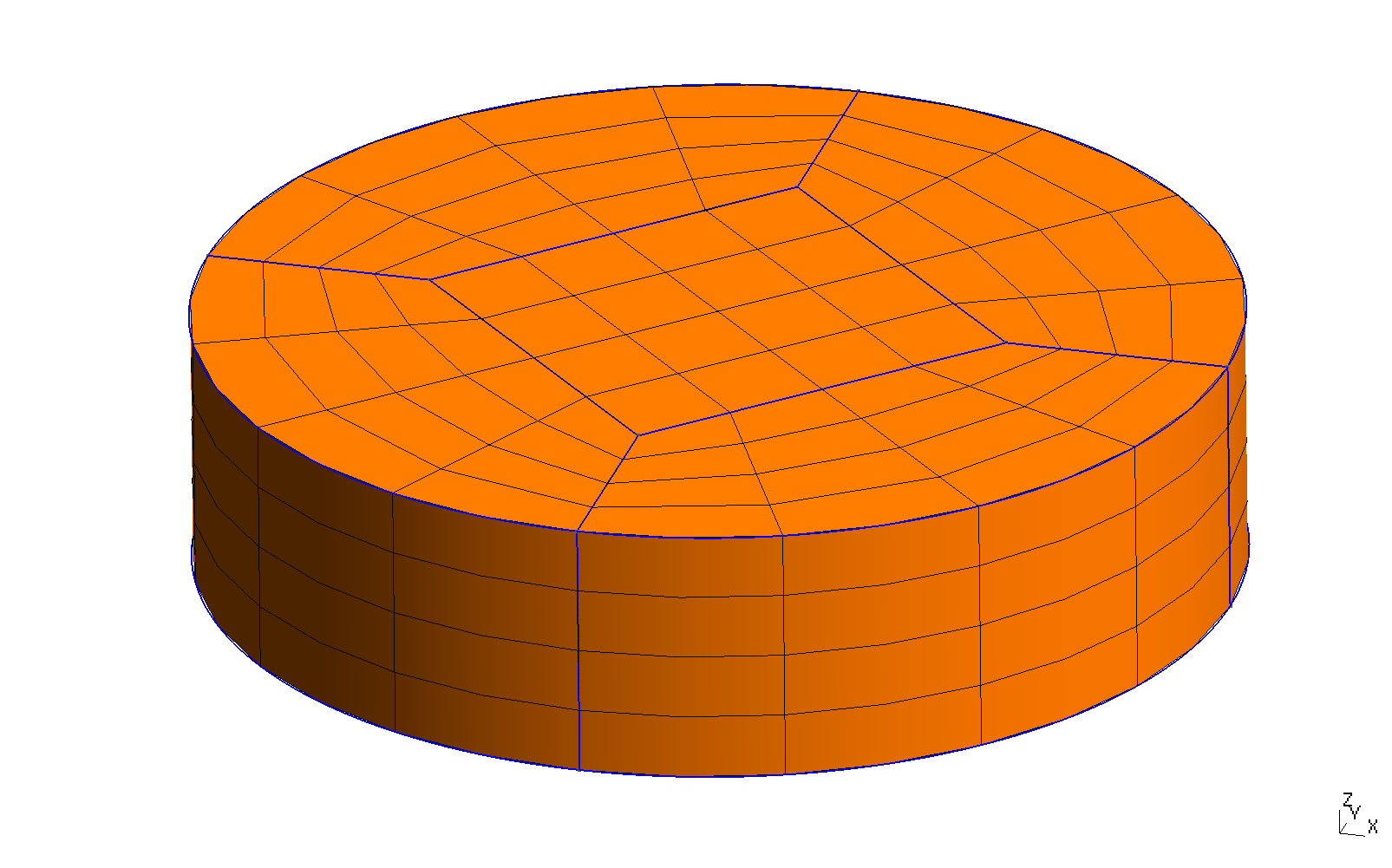
PROBLEM mechanical MESH veeder.msh
b = 1 # cylinder radius
h = 0.5 # cylinder height
E = 1 # young modulus (does not matter for the displacement, only for stresses)
nu = 1/3 # poisson ratio
alpha = 1e-5 # temperature expansion coefficient
# temperature distribution as in the original paper
T1 = 1 # maximum temperature
T0 = 0 # reference temperature (where expansion is zero)
T(x,y,z) = T0 + T1*(1-(x^2+y^2)/(b^2))
# boundary conditions (note that the cylinder can still expand on the x-y plane)
BC inf tangential radial
# write vtu output
WRITE_RESULTS
# non-dimensional numerical displacement profiles
v_num(z') = v(0, b, z'*h)/(alpha*T1*b)
w_num(r') = w(0, r'*b, h)/(alpha*T1*b)
########
# reference solution
# coefficients of displacement functions for h/b = 0.5
a00 = 0.66056
a01 = -0.44037
a10 = 0.23356
a02 = -0.06945
a11 = -0.10417
a20 = 0.00288
b00 = -0.01773
b01 = -0.46713
b10 = -0.04618
b02 = +0.10417
b11 = -0.01152
b20 = -0.00086
# coefficients of displacement functions for h/b = 1.0
# a00 = 0.73197
# a01 = -0.48798
# a10 = 0.45680
# a02 = -0.01140
# a11 = -0.06841
# a20 = 0.13611
#
# b00 = 0.26941
# b01 = -0.45680
# b10 = -0.25670
# b02 = 0.03420
# b11 = -0.27222
# b20 = -0.08167
R(r') = r'^2 - 1
Z(z') = z'^2 - 1
v_ref(r',z') = r' * (a00 + a01*R(r') + a10*Z(z') + a02* R(r')^2 + a11 * R(r')*Z(z') + a20 * Z(z')^2)
w_ref(r',z') = z' * (b00 + b01*R(r') + b10*Z(z') + b02* R(r')^2 + b11 * R(r')*Z(z') + b20 * Z(z')^2)
PRINT_FUNCTION FILE veeder_v.dat v_num v_ref(1,z') MIN 0 MAX 1 NSTEPS 50 HEADER
PRINT_FUNCTION FILE veeder_w.dat w_num w_ref(r',1) MIN 0 MAX 1 NSTEPS 50 HEADER$ gmsh -3 veeder.geo
[...]
$ feenox veeder.fee
$ pyxplot veeder.ppl
$
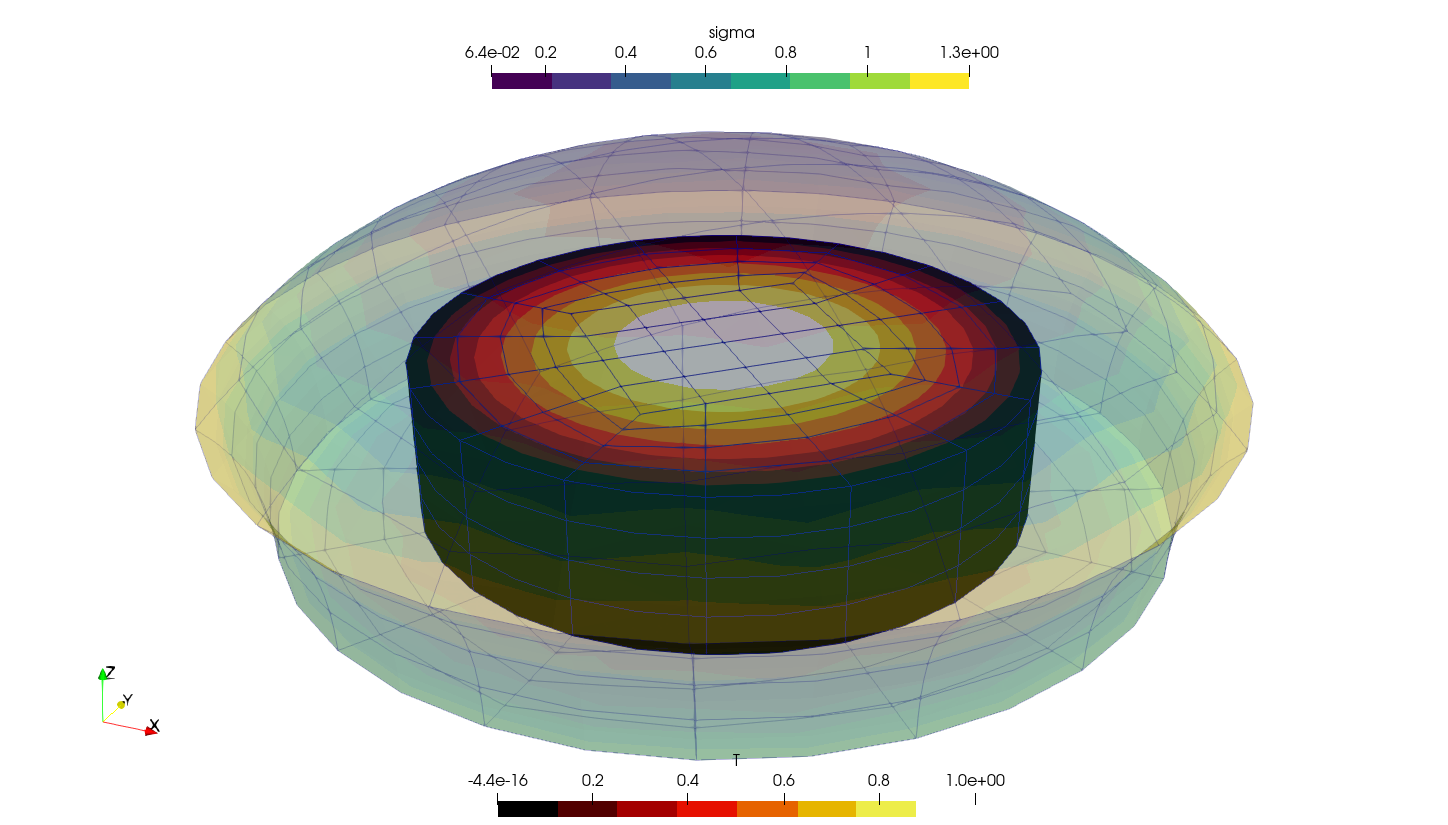
8 Temperature-dependent material properties
Let us solve a plane-strain square fixed on the left, with an horizontal traction on the right and free on the other two sides. The Young modulus depends on the temperature E(T) as given in the ASME II part D tables of material properties, interpolated using a monotonic cubic scheme.
Actually, this example shows three cases:
Uniform temperature identically equal to 200ºC
Linear temperature profile on the vertical direction given by an algebraic expression
T(x,y) = 200 + 350\cdot y
The same linear profile but read from the output of a thermal conduction problem over a non-conformal mesh using this FeenoX input:
PROBLEM thermal 2D READ_MESH square-centered-unstruct.msh # [-1:+1]x[-1:+1] BC bottom T=-150 BC top T=+550 k = 1 SOLVE_PROBLEM WRITE_MESH thermal-square-temperature.msh T
Which of the three cases is executed is given by the first argument
provided in the command line after the main input file. Depending on
this argument, which is expanded as $1 in the main input
file, either one of three secondary input files are included:
uniform# uniform T(x,y) := 200linear# algebraic expression T(x,y) := 200 + 350*ymesh# read the temperature from a previous result READ_MESH thermal-square-temperature.msh DIM 2 READ_FUNCTION T
# 2d plane strain mechanical problem over the [-1:+1]x[-1:+1] square
PROBLEM mechanical plane_strain
READ_MESH square-centered.msh
# fixed at left, uniform traction in the x direction at right
BC left fixed
BC right tx=50
# ASME II Part D pag. 785 Carbon steels with C<=0.30%
FUNCTION E_carbon(temp) INTERPOLATION steffen DATA {
-200 216
-125 212
-75 209
25 202
100 198
150 195
200 192
250 189
300 185
350 179
400 171
450 162
500 151
550 137
}
# read the temperature according to the run-time argument $1
INCLUDE mechanical-square-temperature-$1.fee
# Young modulus is the function above evaluated at the local temperature
E(x,y) := E_carbon(T(x,y))
# uniform Poisson's ratio
nu = 0.3
SOLVE_PROBLEM
PRINT u(1,1) v(1,1)
WRITE_MESH mechanical-square-temperature-$1.vtk E T VECTOR u v 0 $ gmsh -2 square-centered.geo
[...]
Info : Done meshing 2D (Wall 0.00117144s, CPU 0.00373s)
Info : 1089 nodes 1156 elements
Info : Writing 'square-centered.msh'...
Info : Done writing 'square-centered.msh'
Info : Stopped on Thu Aug 4 09:40:09 2022 (From start: Wall 0.00818854s, CPU 0.031239s)
$ feenox mechanical-square-temperature.fee uniform
0.465632 -0.105128
$ feenox mechanical-square-temperature.fee linear
0.589859 -0.216061
$ gmsh -2 square-centered-unstruct.geo
[...]
Info : Done meshing 2D (Wall 0.0274833s, CPU 0.061072s)
Info : 65 nodes 132 elements
Info : Writing 'square-centered-unstruct.msh'...
Info : Done writing 'square-centered-unstruct.msh'
Info : Stopped on Sun Aug 7 18:33:41 2022 (From start: Wall 0.0401667s, CPU 0.107659s)
$ feenox thermal-square.fee
$ feenox mechanical-square-temperature.fee mesh
0.589859 -0.216061
$
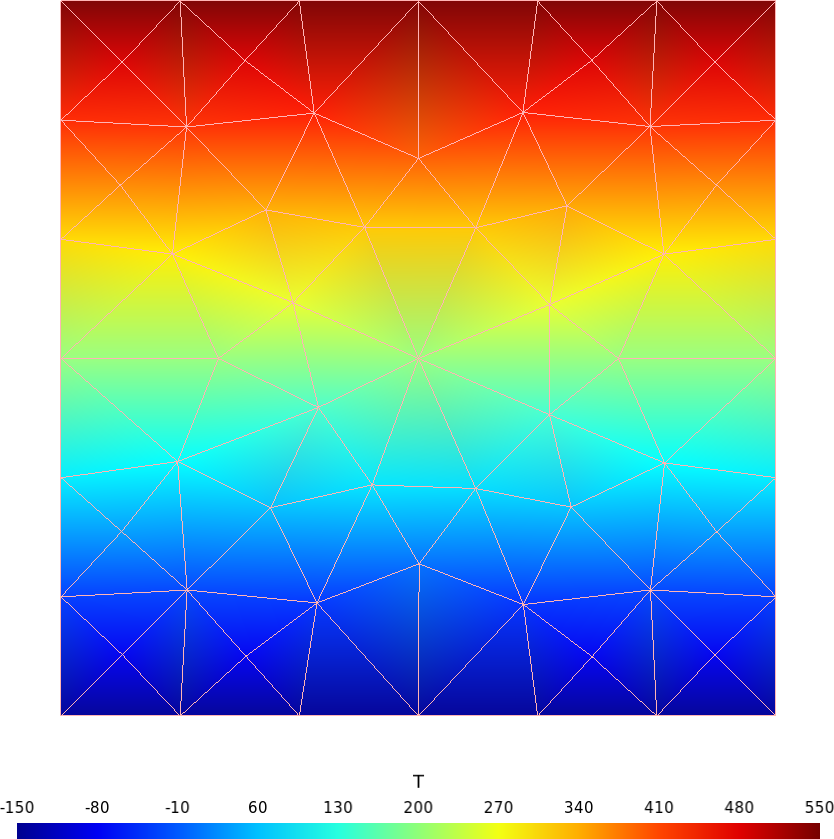
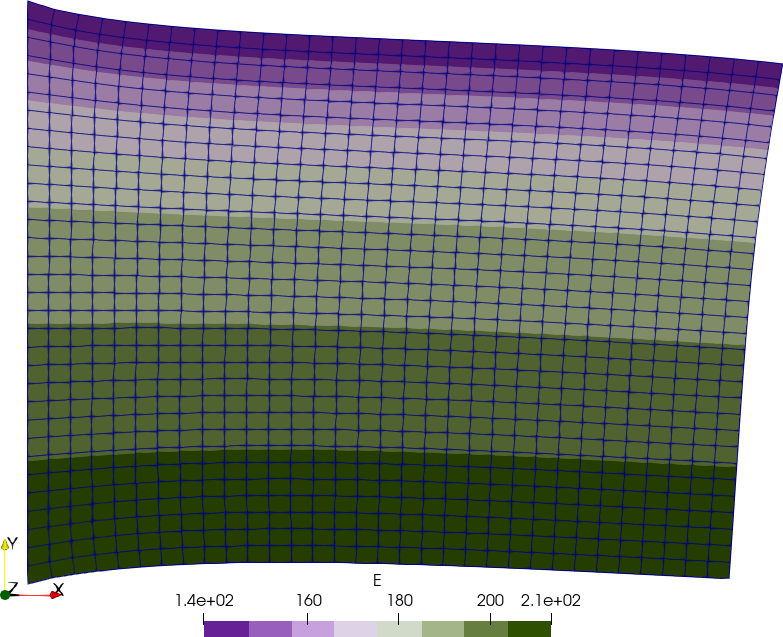
9 Two cubes compressing each other
Say we have two cubes of non-dimensional size 1\times 1 \times 1, one made out of a
(non-dimensional) “soft” material and one made out of a “hard” material.
We glue the two cubes together, set radial and tangential symmetry
conditions on one side of the soft cube (so as to allow pure traction
conditions) and set a normal compressive pressure at the other end on
the hard cube. Besides on single VTU file with the overall results, the
von Mises stress output is split into two VTU files—namely
soft.vtu and hard.vtu where the stress is
non-zero only in the corresponding volume.
This example illustrates how to
- assign different material properties to different volumes
- write VTU outputs segmented by mesh volumes
- write results at nodes (default) and at cells
PROBLEM mechanical 3D
READ_MESH two-cubes2.msh
MATERIAL left E=1 nu=0.35 mat=1
MATERIAL right E=10 nu=0.25 mat=2
# BCs
BC zero tangential radial
BC ramp p=0.25
SOLVE_PROBLEM
sigma_at_1(x,y,z) = sigma(x,y,z)*(mat(x,y,z)=1)
sigma_at_2(x,y,z) = sigma(x,y,z)*(mat(x,y,z)=2)
WRITE_RESULTS FORMAT vtu displacements vonmises
WRITE_MESH two-cubes-left.vtu sigma_at_1 CELL NAME sigma_at_1_cells sigma_at_1
WRITE_MESH two-cubes-right.vtu sigma_at_2 CELL NAME sigma_at_2_cells sigma_at_2$ gmsh -3 two-cubes.geo -order 2 -o two-cubes2.msh
[...]
$ feenox two-cubes-mechanical.fee --mumps
$
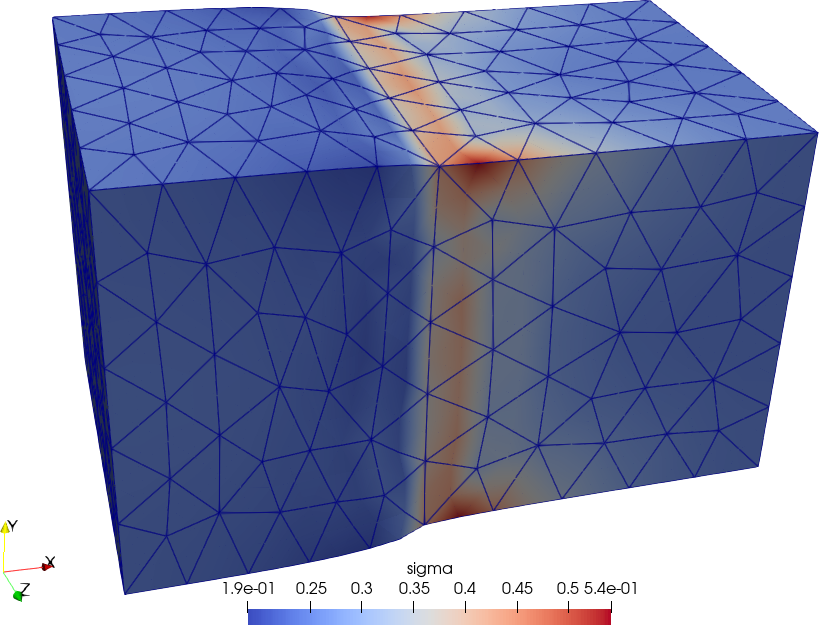
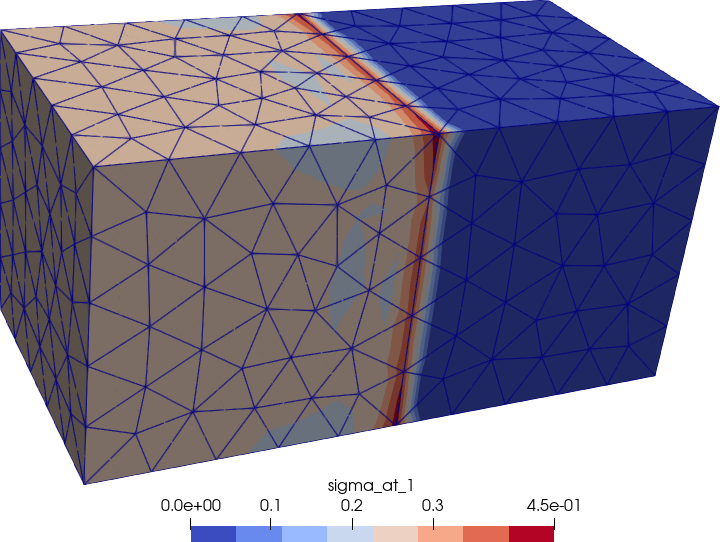
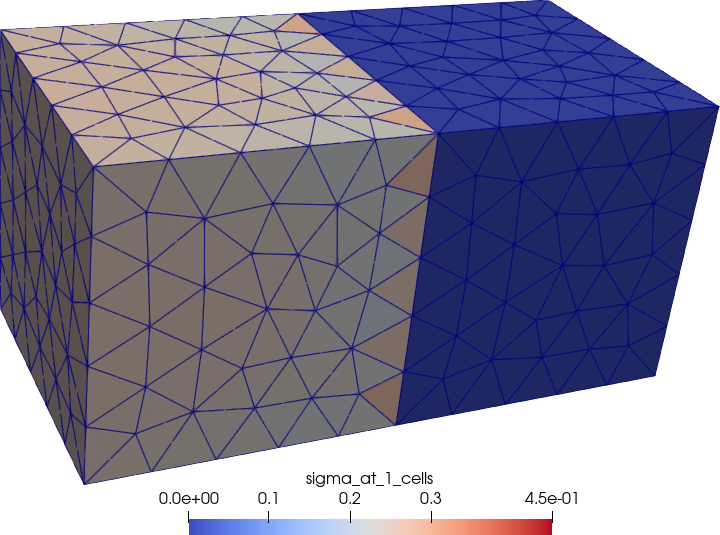
Figure 5: Von Mises stresses non-zero only over the left (soft) cube.. a — Data at nodes, b — Data at cells
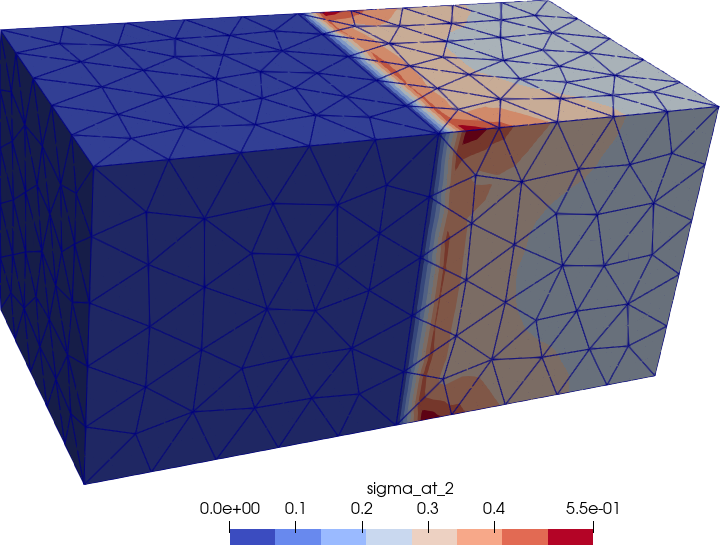
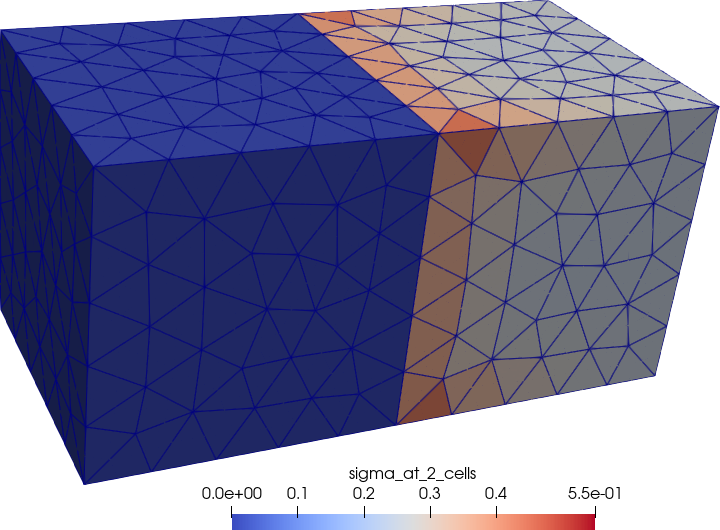
Figure 6: Von Mises stresses non-zero only over the right (hard) cube.. a — Data at nodes, b — Data at cells
10 Steel/aluminum paradox
Can the maximum displacement decrease if we replace one of the steel components in the assembly by an aluminum component of the same geometry?
Consider the following configuration
for the following two cases:
- blue and pink is steel
- blue is steel and pink is aluminum
We can create this geometry in Gmsh as
SetFactory("OpenCASCADE");
Box(1) = {0, 0, 0, 5.5, 1, 1};
Box(2) = {5, 1, 0, 5, 1, 1};
Box(3) = {10, 1, 0, 5, 1, 1};
Coherence;
Mesh.MeshSizeMax = 0.2;
Mesh.ElementOrder = 2;
Physical Volume("pink") = { 1 };
Physical Volume("blue") = { 2, 3 };
Physical Surface("fixed", 35) = {1};
Physical Surface("2p", 36) = {8};
Physical Surface("p", 37) = {14};
Physical Curve("pin", 38) = {19};and then call FeenoX twice with either steel or
alum in the command line to see which case has a larger
deflection.
PROBLEM mechanical MESH steel-alum.msh
MATERIAL steel E=210e3 nu=0.3
MATERIAL alum E=69e3 nu=0.25
# choose the material for the pink block from command line
PHYSICAL_GROUP pink MATERIAL $1
PHYSICAL_GROUP blue MATERIAL steel
BC fixed fixed
BC pin v=0
F = 1000
BC p Fy=-F
BC 2p Fy=-2*F
WRITE_RESULTS
PRINT %.1f displ_max$ gmsh -3 steel-alum.geo
[...]
$ feenox steel-alum.fee steel
3.9
$ feenox steel-alum.fee alum
2.6
$
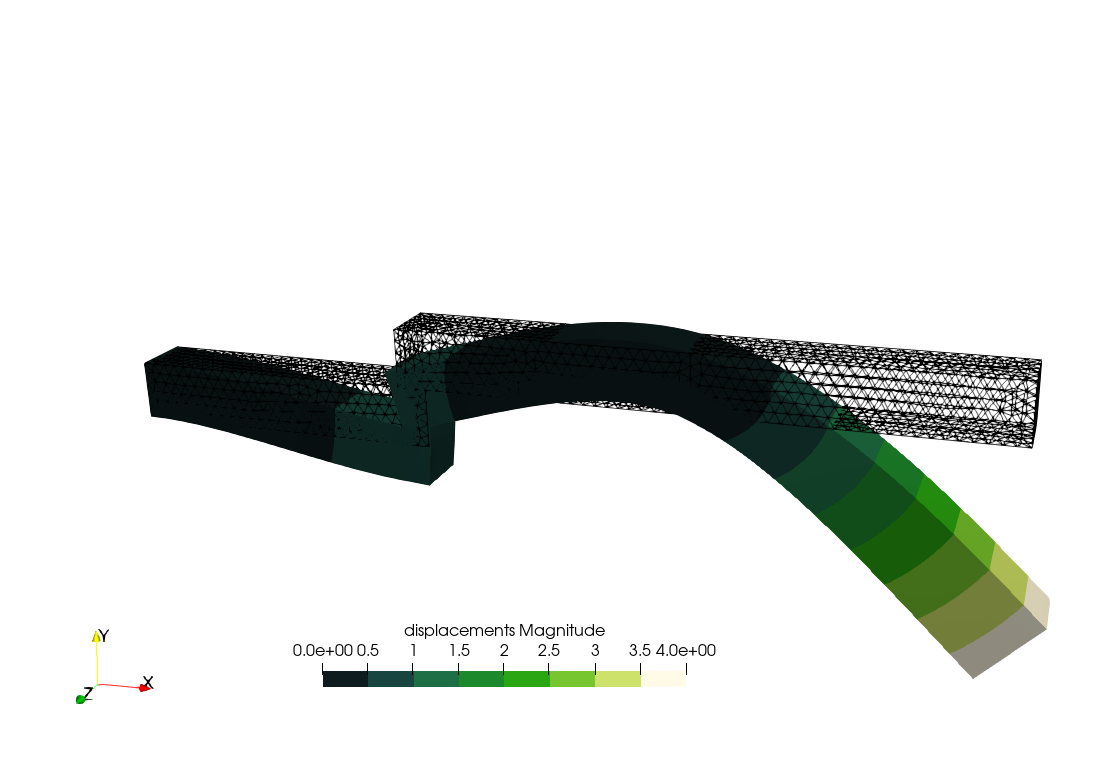
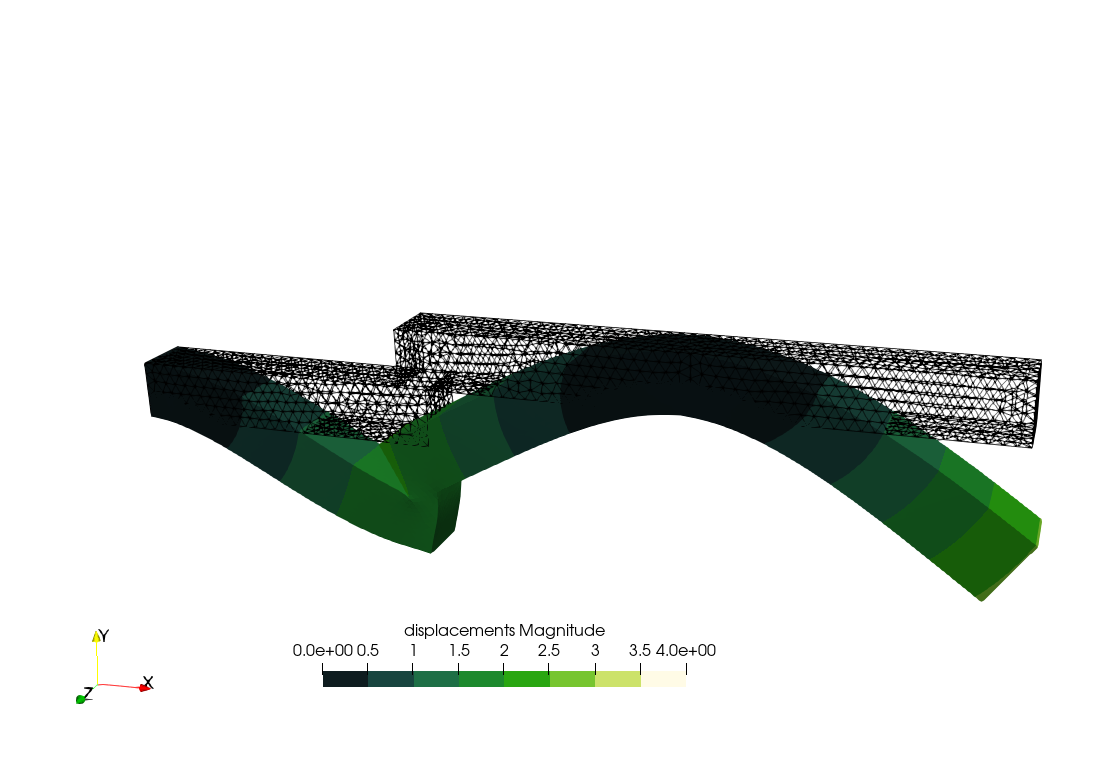
Figure 7: The Steel/aluminum paradox: replacing steel with aluminum gives rise to smaller maximum displacements.. a — Pink is steel, b — Pink is aluminum
11 NAFEMS GNL5 “Large-deformation beam”
Large-strain problems in FeenoX are WORK IN PROGRESS. Evaluation of stresses, performance, parallelization, etc. will improve. Take this example with a grain of salt.
Consider a cantilevered beam with a square 0.1~\text{m} \times 0.1~\text{m} cross section and axial length 3.2~\text{m} along the x axis. The material es linear elastic with E=2.1 \times 10^{11} \text{Pa} and \nu=0. The left end at plane y-z is fixed. The right end is subject to a total load of F_x = -3.844 \times 10^6~\text{N} (compressive) and F_y = -3.844 \times 10^3~\text{N} (downward).
A large-deformation buckling effect is expected due to the massive compression of a slender structural geometry and the slight 0.1\% loading imperfection in the y direction. The reference results are
| Scalar quantity | Reference result |
|---|---|
| Maximum vertical displacement at the tip | (-2.58 \pm 0.02)~\text{m} |
| Final vertical displacement at the tip | (-1.36 \pm 0.02)~\text{m} |
| Final vertical displacement at the tip | (-5.04 \pm 0.04)~\text{m} |
To solve the problem, let’s start with a Gmsh input file to create a nice structured hex20 mesh:
SetFactory("OpenCASCADE");
l = 3.2;
h = 0.1;
Box(1) = {0, -h/2, -h/2, l, h, h};
Physical Surface("left") = {1};
Physical Surface("right") = {2};
Physical Volume("steel") = {1};
n = 2; // number of elements across thickness
Transfinite Curve {2, 4, 3, 1, 7, 8, 5, 6} = n+1;
Transfinite Curve {11, 12, 9, 10} = n*32+1;
Transfinite Surface "*";
Transfinite Volume "*";
Mesh.RecombineAll = 1; // quads & hexes
Mesh.ElementOrder = 2; // second order
Mesh.SecondOrderIncomplete = 1; // hex20 (and quad8) instead of hex27 (quad9)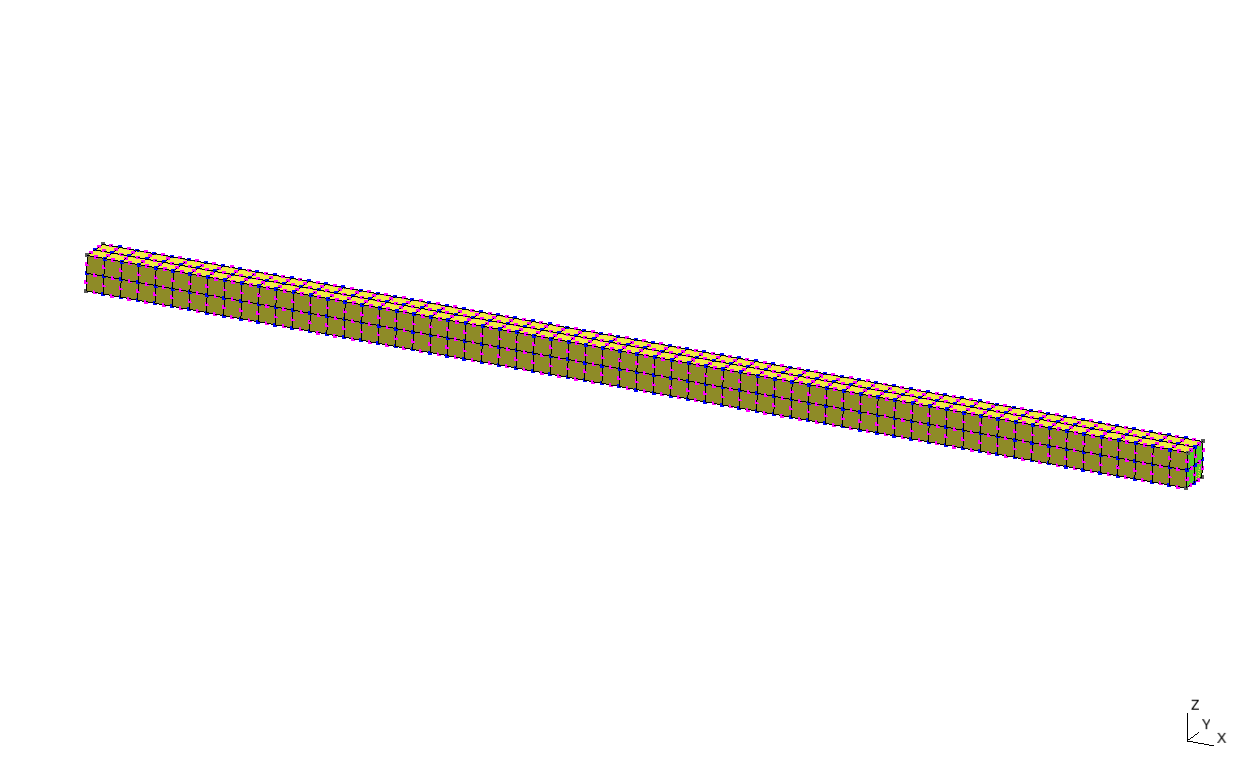
This problem is non-linear and path dependent so we have to make sure FeenoX can detect the critical buckling load, otherwise it might converge to other possible solutions.
For that end, we run a quasi-static problem with a non-dimensional
time t from t=0 up to t=1 (i.e. end_time = 1) and
scale the loads with the factor t. We
start with \Delta t_0 = 0.01
(i.e. dt_0 = 1e-2 meaning 1\% of the load) and then allow FeenoX to
choose the time (load) step.
In FeenoX, to use a linear-elastic isotropic material model in the large-deformation (a.k.a. Saint Venant-Kirchoff model) one can either
keep E and \nu as global variables
Eandnurespectively as in the linear case above and then- set the special variable
ldefto non-zero, or - write the
NONLINEARkeyword in thePROBLEMline, or - pass
--non-linearoption in the command line, or
- set the special variable
write a special
MATERIALwithMODEL svklikeMATERIAL E=2.1e11 nu=0 MODEL svk
In the actual input file we use a-i:
# NAFEMS Geometrically-Non-Linear cantilever beam
PROBLEM mechanical MESH nafems-gnl-cantilever.msh
E = 2.1e11 # linear elastic material
nu = 0
ldef = 1 # with large-strain (i.e. SVK model)
end_time = 1 # quasistatic (because problem is mechanical)
dt_0 = 1e-2 # initial time step = 1%
min_dt = 1e-3 # minimum load increament = 0.1%
# boundary conditions with loads scaled by t
BC left fixed
BC right Fx=-3.844e6*t Fy=-3.844e3*t
SOLVE_PROBLEM
# show step, t, incremente and horizontal and vertical displacements
PRINT step_transient t dt u(3.2,0,0) v(3.2,0,0)
# write one vtu for each step and a global pvd file
WRITE_RESULTS$ gmsh -3 nafems-gnl-cantilever.geo
[...]
$ feenox nafems-gnl-cantilever.fee | tee nafems-gnl-cantilever.dat
[...]
$ awk '{print $5}' nafems-gnl-cantilever.dat | sort -rg | tail -n1
-2.58023
$ awk '{print $5}' nafems-gnl-cantilever.dat | tail -n1
-1.33159
$ awk '{print $4}' nafems-gnl-cantilever.dat | tail -n1
-5.08797
$ ./quasistatic-video.py nafems-gnl-cantilever.pvd
[...]
Saved animation to nafems-gnl-cantilever.pvd.mp4
$ pyxplot nafems-gnl-cantilever.ppl
$
Take some time to compare FeenoX’s approach, namely
- one text file for the geometry
- one text file for the problem,
- a solver designed to follow the Unix philosophy
- standard Unix tools to get results
against the proposed way to solve this very same problem with a point-and-click tool. Spoiler: it needs 15 pages of instructions about where to click to solve the problem.
